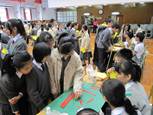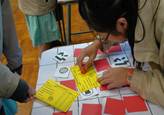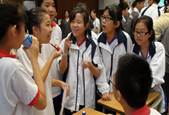LAC Periods
Data analysis |
-
Collecting information of various kinds on content subjects
Teachers first studied the subject textbooks, junior form syllabus, the NSS curriculum and the requirements of the HKDSE papers. Some common elements such as the use of knowledge structures, a variety of text types and development of higher-order thinking skills were identified.
-
Interviewing content subject teachers
In order to get a broad picture of students’ learning, especially the difficulties they encountered in learning content subjects, the English teachers interviewed different content subjects teachers to collect more information. They found that students’ academic vocabulary was limited and they lacked vocabulary building skills. Secondly, they were weak in organising and expressing ideas logically and systematically when writing essays or reports in their own subjects. Thirdly, they lacked reading strategies to comprehend some content reading materials and the writing skills to present and elaborate information and ideas in a structured and systematic manner.
|
Curriculum content



|
Here are the key features of the curriculum content:
-
Use of content subject materials
In order to increase students’ language use in content subjects, the teachers used content subject materials as the backbone of the entire curriculum. All the topics discussed and strategies used were illustrated through subject specific materials.
-
Equipping students with vocabulary building skills
Building a good vocabulary foundation is an important step to develop students’ academic literacy. In the LAC periods, the teachers therefore taught the concept of root_words, common prefixes_and_suffixes by using content subject vocabulary as an illustration. This would help students to predict the meaning of some subject specific vocabulary, interpret text and express ideas freely in their spoken or written language.
To develop students’ learner independence, teachers also designed a self-study_booklet with vocabulary of different subjects and examples for their own learning during spare time. This helped them to build their vocabulary bank and further explore the meanings of words for their own enjoyment .
-
Use of knowledge structures
To help students construct and apply knowledge and ideas in a logical & structured manner, the teachers integrated some core knowledge structures such as “comparison and contrast” and “cause & effect” into the programme content. They also highlighted the use ofsignal words to connect concepts & ideas logically and systematically. Thus students could better comprehend content reading texts and develop their thinking skills.
-
Infusing higher-order thinking structures
In order to stimulate students’ critical thinking skills, some higher-order thinking structures such as inferencing & problem-solving were embedded in the teaching content. With the help of some motivating tasks, students were able to think critically by giving opinions and making personal judgments. This greatly helped them to become self-directed and critical readers.
-
Developing students’ discussion skills
Equipping students with the necessary discussion strategies and language structures not only helps them to organize their ideas and thoughts but also develops an open and critical mind to accept different points of views and ideas from others. The teachers provided some interactive tasks to enable students to communicate and share their opinions with supportive reasons. Teachers also provided students with the language input and necessary skills to facilitate their discussion. This certainly helped them to deepen their understanding of the topic and explore their learning.
|
Strategies used



|
-
Step-by-step approach
A gradual approach was used to help students scaffold their learning. Take cause & effect as an example. Before introducing the knowledge structures to students, teachers motivated students by using an authentic situation about falling in love with a classmate as an entry point. Students were asked to discuss in pairs about possible causes and effects in this context. Teachers then gave a short content reading text to students to identify the related knowledge structure. After that, they introduced the relevant signal words and phrases needed for showing cause and effect relationship and provided them with some follow-up exercises to apply the language learnt. Then the teachers provided them with a content reading text as input and a content writing task as output. Through these activities, students were able to internalise the knowledge and skills in a step-by-step manner.
-
Use of graphic organizers
To help students to conceptualise the knowledge learnt, teachers made use of the graphic organizers such as “describing a process”, “comparison & contrast” & “cause & effect” to help students to construct and apply the knowledge and skills learnt. This strategy is useful for supporting students to convert complex information into meaningful display, resulting in enhancing their skills in comprehending the content reading text and planning and structuring their essay writing.
-
Use of interactive tasks
In order to make the lessons more motivating and communicative, teachers designed some interactive group work and pair work during lessons for students to apply the language learnt. Through these interactive activities, students learned how to share their ideas with their classmates and use English to apply the language learnt in authentic contexts.
-
Reading to writing approach
In order to increase students’ language exposure in different subjects, teachers integrated different content related topics at their levels to motivate them. For example, topics of different subjects such as “What is Integrated Science”, “Life in ancient Egypt” and “Water cycle” were used to arouse students’ interest in learning in IS, History & Geography. They also integrated a variety of text types such as diagrams, pictures and videos to arouse students’ interest in their learning. Not only did these text types stimulate students’ thinking, they also raised their awareness of applying the language in different contexts.
After introducing the content reading, teachers designed some questions or activities to test students’ understanding of the passage and also helped them to interpret and analyse the text so that they could conceptualise and consolidate the knowledge and language learnt.
A gradual approach was adopted for equipping students with writing skills.Teachers first introduced a basic text structure of writing to students such as an introduction, a body and an ending. In the body part, they shared with them how to write topic sentences for each paragraph. Based on the model given, they asked students to write a problem and solution article in a different context. Students were given information as input about the topic they needed to write. Then they made use of the graphic organizers to construct their ideas and information. Finally, they presented the information in the form of a systematic and well-structured writing. Through these learning steps, students were able to develop their academic literacy skills in writing.
|
Assessment |
In order to collect feedback about students’ learning, mid-term_tests_&_exams were designedto test their language ability to construct and apply knowledge in content subjects.
|
LAC Days
Programme content
Subject |
Date |
Target Group |
Time |
Venue |
I.S. |
17 October |
S1 |
Lunch |
Hall |
Geography |
2 December |
S2 |
Lunch |
Hall |
Mathematics |
20 April |
S1 |
Lunch |
Hall |
History |
22 November |
S1 |
Lunch |
Hall |
17 May |
S2 |
Lunch |
Hall |
Technology |
6 December |
S1 & S2 |
Lunch |
Hall |

|

|

|
(Students were actively involved in various kinds of content-subject related activities.) |
Strategies adopted
A variety of KLAs were included in this cross-curricular activity. There was a variety of topics covered which students are interested in & familiar with such as body structure and use of apparatus from IS, ancient civilization from History and map reading and continents from Geography. In these topics, the subject specific vocabulary and related concepts were revised. To make the programme more interesting, different games & activities were designed to motivate the students. Some books were given to students as prizes & rewards.Based on the feedback collected, they enjoyed the activities and it also provided an opportunity for them to practise using the academic English in content subjects in a relaxed and enjoyable manner. |

